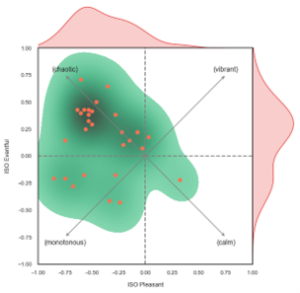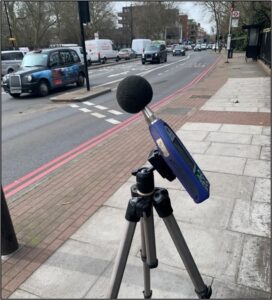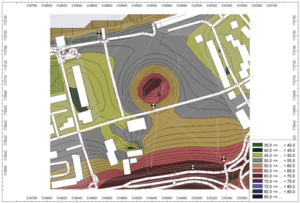What are Soundscapes?
Soundscapes describe the human perception of an acoustic environment. A standard method exists for robust justifiable analysis (BS ISO 12913).
The acoustic environment includes things such as noise levels and types of noise which are mostly objective descriptors.
Soundscapes describe how different people may perceive the acoustic environment in context and are largely subjective. e.g. is the environment chaotic or calm, or is it monotonous or vibrant?
Why undertake soundscape assessment?
There are several reasons to undertake a soundscape assessment:
- To characterise an existing soundscape:
- Inform and empower authorities in making sustainable planning decisions
- To recommend improvements or aid in the design of a space to make it more pleasant or appropriate
- To understand the potential impact of changes to the soundscape as a result of new developments
- To characterise a proposed or completed soundscape:
- Create auralisations of the proposed acoustic environment to gather how it will be perceived through virtual soundwalks
- Compare the previous and completed soundscapes to understand how people perceive the change (traffic calming schemes, trial changes to parks etc.)
Whilst soundscapes have generally been focussed towards outdoor spaces, the process and assessment can be modified to relate to indoor assessments of buildings where acoustics are important i.e. museums, galleries, concert halls, venues etc.
How do we undertake soundscape assessments?
Soundwalks
Soundwalks are a walk with a particular focus on listening to the environment, they will cover several locations where participants will stop and listen for a few minutes and answer predefined questions based on how they feel and perceive the sound environment.
Soundwalks offer a great way to engage with stakeholders or decision makers. Whilst the questionnaire is the principal way of collecting data, the process of walking and talking can also highlight any additional concerns or thoughts.
Remote Soundwalks
Temple has developed our process for undertaking remote soundwalks. These include attending the site with a 360-video camera and ambisonic/binaural recording devices to record video and sound. These are then post-processed into 360 videos that can be played back alongside an online questionnaire to re-create the soundwalk. This allows for greater inclusion regarding the people who can take part and also allows for a repeatable exercise that could be re-used and compared. For example, collecting video and audio before and after traffic calming measures so that residents who may be affected by future measures can get a greater understanding of the changes or impact.
Questionnaire
The questionnaire used during soundwalks includes sound source identification, questions around perceived affected quality, assessment of the sound environment (good or bad) and the appropriateness of the sound environment (very or not at all).
Questionnaire data is then post-processed for all participants to give ‘attitude plots’ for each location, which give a visual representation of how people perceive an acoustic environment.


Data can be processed further based on anonymised demographic data recorded during the survey to understand how different groups feel about a certain location.
Analysis & modelling
Quantitative data recorded using sound recorders and noise monitors is also post-processed into 360 videos, noise descriptors (LAeq, LAmax etc.) and noise maps.
Noise models can be created based on the data recorded to aid in visualising quantitative and qualitative data side-by-side.

Auralisation
For future developments where a new or modified soundscape is expected, Temple can create these future soundscapes that may take into account new, louder, quieter or removed noise sources.
As soundscapes are an emerging area in acoustics, we can provide a CPD session covering the basics, along with an example Remote Soundwalk.